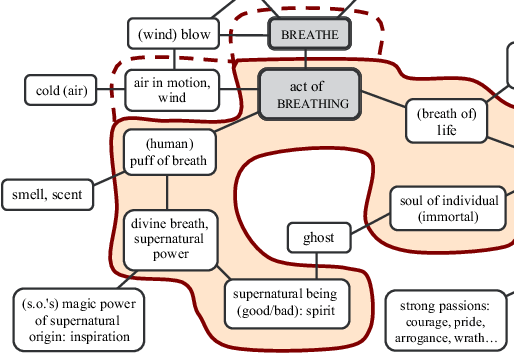My research includes a particular interest for lexical structures across the world's languages, i.e. the manner in which meaning is distributed across linguistic forms in lexicons of the world. This research agenda is known as lexical typology.
From etymology to lexicography
I developed my passion for lexical semantics as I studied classical languages (Greek, Latin, PIE reconstruction…) and learned about semantic change from ancient languages to modern times. My interest was renewed as I researched the Oceanic languages of Vanuatu: this has led to various lexicographic projects, in the form of printed or electronic dictionaries of various languages of Vanuatu (Araki, Mwotlap, Lo-Toga, Hiw) and the Solomons (Teanu, Lovono, Tanema).
Colexification and the typology of synchronic polysemies
 In parallel with my descriptive work on Oceanic languages, I began searching for universal patterns of polysemy by proposing the new concept of colexification – that is, the phenomenon whereby distinct concepts can be expressed identically (=can be “co-lexified”) in certain languages.
In parallel with my descriptive work on Oceanic languages, I began searching for universal patterns of polysemy by proposing the new concept of colexification – that is, the phenomenon whereby distinct concepts can be expressed identically (=can be “co-lexified”) in certain languages.
- François, Alexandre. 2008.
Semantic maps and the typology of colexification: Intertwining polysemous networks across languages. In Martine Vanhove (ed.). From Polysemy to Semantic change: Towards a typology of lexical semantic associations. Studies in Language Companion Series, 106. Amsterdam, New York: Benjamins. 163-215.
My concept of colexification – and/or the method he proposed for building semantic maps to represent patterns of colexification – have since inspired numerous scientific works, in the domains of lexical typology, cognitive semantics or natural language processing (NLP).

Semantic change and “lexical tectonics”
More recently, I endeavoured to broaden his reflection by focusing on the diachronic dimension of semantic associations, namely semantic change and etymology. This took the form of various publications:
- François, Alexandre. 2013.
Shadows of bygone lives: The histories of spiritual words in northern Vanuatu. In Robert Mailhammer (ed.). Lexical and structural etymology: Beyond word histories. Studies in Language Change, 11. Berlin: DeGruyter Mouton. 185-244.
- —— 2022a.
Awesome forces and warning signs: Charting the semantic history of *tabu words in Vanuatu. Oceanic Linguistics 61/1 (June 2022), 212-255.
- —— 2022b.
Lexical tectonics: Mapping structural change in patterns of lexification. Zeitschrift für Sprachwissenschaft 41/1: 89‒123.
The metaphor of “lexical tectonics” captures the phenomenon of semantic change in the lexicon, as word meanings progressively evolve over time. The slow reshaping of each word's profile in semantic space somehow reminds us of tectonic plates, and how they drift in a way that slowly reshapes our geographical landscapes.

Dialexification, a tool for studying semantic change

In 2023, in order to study the diachronic dimension of colexification, I coined the new concept of dialexification. Dialexification captures the relation between “cognate meanings”: that is, if two words in different languages are cognate (=descended from the same etymon), then the meanings of those words will be dialexified. For example, French entendre 'hear' & Spanish entender 'understand' show that the two concepts {hear—understand} are “dialexified” in the Romance family.
- Alexandre François & Siva Kalyan. 2023. Dialexification: A tool for studying cross-linguistic patterns of semantic change – Paper presented at ICLC16 (16
th International Cognitive Linguistics Conference), Heinrich-Heine-Universität, Düsseldorf. Aug 2023.
𝓔𝓿𝓸Sem: A database of dialexification
This concept of dialexification has given rise to a new online project: 𝓔𝓿𝓸Sem. This database of dialexification explores historical relations between concepts, based on their etymological links in dozens of different language families across the world.
[Mathieu Dehouck, Alexandre François, Siva Kalyan, Martial Pastor & David Kletz]
𝓔𝓿𝓸Sem: A database of polysemous cognate sets.
In Nina Tahmasebi et al. (conv.), Proceedings of the 4th Workshop on Computational Approaches to Historical Language Change, 66–75. Singapore. Association for Computational Linguistics.
Visit the 𝓔𝓿𝓸Sem database.

